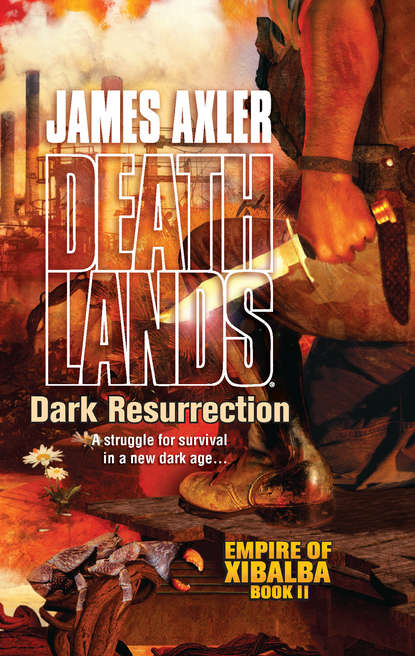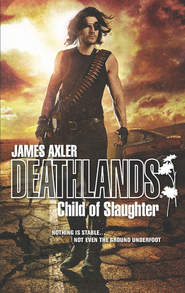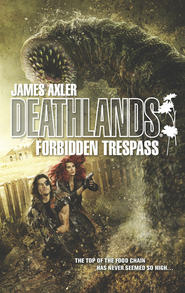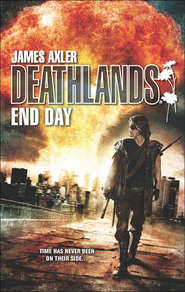По всем вопросам обращайтесь на: info@litportal.ru
(©) 2003-2024.
✖
Dark Resurrection
Автор
Год написания книги
2019
Настройки чтения
Размер шрифта
Высота строк
Поля
The ship’s horn blasted overhead; the sister ships behind chimed in, as well, announcing the Matachìn convoy’s triumphant return to what Ryan could only guess was its point of origin.
In the lee of the peninsula, under scattered bright lights on tall stanchions, were the remains of a commercial shipyard—docks and cargo cranes. The scale of the development dwarfed what they had seen at Port Arthur ville. The structures hadn’t escaped Armageddon unscathed, though. It looked like they had been slammed by tidal waves or earthquakes. Most of the metal-frame industrial buildings were flattened to their concrete pads. Towering cargo cranes canted at odd angles; some had toppled into the water. The enormous docks were broken, wide sections of decking were missing; moored to the remnants were a hodge-podge of small trading vessels. Beyond the docks, where the peninsula met the mainland, stood a power plant that was fully operational. Floodlights illuminated clouds of smoke or steam from a trio of tall stacks. Over the noise of the diesels, the complex emitted a steady, high-pitched hum.
The lead tug continued, hugging the inside of the peninsula, passing within a hundred yards of another immense structure—a fortress made of heavily weathered, light gray stone, also dramatically lit. Apparently constructed on an offshore island, it was connected to the mainland by a low, stone bridge. Above its crenellated battlements, at either end of the enclosed compound, were cylindrical observation towers. Huge iron anchor rings hung in a row just above the waterline. In front of the high-arched entrance gate, small motor launches were tied up to mooring cleats. Eroded stone sentry boxes bracketed the gate.
The mini-island fortress was a time-worn anachronism, but it had been built to last; it had survived nukeday virtually intact, whereas the twentieth-century artifacts that surrounded it had not.
“It’s an old Spanish fort from colonial days,” Doc ventured. “Probably six hundred or more years old. Those massive, triangular blockhouses outside the corners of the bastion walls are called ravelins. They were designed to defend the main perimeter from attack by offering a protected position for flanking fire. In the sixteenth and seventeenth centuries Spaniards used stone forts like that to store gold and silver mined from the New World. It could also defend the city from pirates and foreign invaders—French, English, American.”
Even bathed in hard, bright light, evil seem to emanate from the structure, from the very seams in its masonry.
Ancient squatting evil.
A consequence of the uncounted thousands who had died as prisoners in its belly, between its teeth, under its claws.
“The question is, what is it now?” Mildred said.
“Those cannons sticking out of the battlements sure as hell aren’t six-hundred-year-old muzzleloaders,” J.B. said. “If I had to guess I’d say they’re at least 106 mm with mebbe a one-mile range. That means nobody comes in or goes out of the harbor without coming under their sights.”
As the tug motored through the sheltered waters of the harbor, past the fort’s arched gate, a gaggle of armed men spilled through it, waving and cheering in welcome. They didn’t look anything like the Matachìn. No dreads. No battle armor. They weren’t wearing uniforms as such, more like insignia. They all had crimson sashes over their right shoulders and opposite hips, and they wore off-white straw cowboy hats with rolled brims. Their shoulder-slung weapons were different from what the Matachìn carried. The wire-stocked, stamped-steel submachine guns were much more compact, like Uzi knock-offs, with the mags inside the pistol grips. Men in crimson sashes continued to pour out of the gate, onto the dock.
“Sec man garrison,” Ryan said flatly.
Fireworks whistled from the battlements, arcing high into the black sky, and there exploding into coruscating patterns of green, gold and red.
The tug chugged on, turning left for the nearby mainland.
Looking over his shoulder at the wreckage of the peninsula, Ryan guessed that it had taken the brunt of nukeday tidal waves, in effect absorbing most of the energy before it reached the city on the inside of the harbor.
Off the bow, Veracruz glowed incandescent against the black-velvet sky. The one-eyed warrior could make out individual pinpoints of light from the upper story windows of the tallest buildings. At the edge of the city, a long pier jutted into the water; it was overlooked by a lighthouse.
When the tug came within four hundred yards of the pier, Ryan saw it was packed end to end; thousands of people had assembled and were waiting for them to arrive. Another hundred yards closer and he could see that the overloaded dock was just the tip of the crowd, which stretched unbroken, back into the brightly lit city streets. There was no telling how far back it went. The throng was like a single entity, a vast amoeba-thing in constant, chaotic motion, only kept from spilling out in all directions by the building walls on either side. Between celebratory blasts of the ships’ horns, Ryan heard yelling and blaring fragments of music. The din got even louder as the tug pulled alongside the pier. The music—caterwaul singing backed by frenzied fiddle, drums and guitar—boomed down from loudspeakers mounted on the lamp posts.
A sea of sweaty, brown faces greeted them.
The wildly excited citizens of Veracruz waved Day-Glo-colored plastic pennants emblazoned with unintelligible symbols. They held ten times larger-than-life-size papier-mâché heads on long poles, which they jigged up and down. Some of the paper sculptures had flat noses, ornate headdresses and leering mouths lined with cruel fangs. The colors were bizarre instead of lifelike—glistening green or pink skins, pointed black tongues, insane red and purple eyes with yellow pupils. Ryan strained to read the words written across their neckplates: Atapul the First; Atapul the Second; and so on, up to Atapul the Tenth.
They were names, he figured.
Ryan had no clue what the stylized images represented, whether they were gods or barons, but the meaning of some of the other sculpted faces was all too apparent. Bobbing in front of him on pikes were gigantic human heads with a ghastly bluish pallor, bleeding from nose, eyes and mouths. Cheeks and foreheads were speckled with red dots. Their expressions were fixed in rictus agony and terror.
Plague masks.
Plague like the one that had struck Padre Island.
Mildred squeezed his arm hard to get his attention, then raised her manacled hands to point toward the landward, lighthouse end of the pier.
There, not thirty yards away, on the end of a wooden pole, ten times life size, was Ryan’s own face, or a close approximation thereof. It was crudely rendered and painted, but all the pertinent details were there: the black eye patch, the scar that split his brow, the dark curly hair, the single surviving eye, the bearded cheeks, the square chin. The only difference was, the patch and scar had been reversed on the sculpture, as if he was staring into a mirror.
There were more of the giant, eye-patch faces spaced here and there among the seething throng.
“What the fuck?” Ryan said.
Chapter Two
Harmonica Tom stood at the helm of Tempest, feathering the engine’s throttle to maintain a constant safe distance from the row of ship lights in front of him. He ran the forty-foot vessel blacked-out, as he had done every night for the last three weeks, every night since he’d escaped from Padre Island. Finding the pirate convoy after dark was a piece of cake for the seasoned skipper. The six target boats were always lit up, mast, bow and stern; this to help keep them from crashing into one another.
During the day, Tom had to lay back in his pursuit for fear a crow’s-nest lookout would glimpse his mast tops astern. The last thing he wanted was for part of the fleet to peel off and double back to check out who was following its wake. The seagoing trader was sure they’d have no trouble recognizing Tempest: he’d already used it to kick their asses once. Unfortunately, he’d only managed to sink a single ship, while damaging two others. The fallback in pursuit meant he had to do some zigging and zagging to find the convoy again after sundown.
No problem this night, though.
The Matachìn ships were under engine power; even the slave galley tugs were burning diesel. And they were heading in toward the coast, making for the corona of shimmering lights low on the horizon.
By Tom’s map reckoning, it had to be Veracruz.
It was starting to look like the fire talkers’ stories were all true. That there really was a wider and more prosperous world than Deathlands, existing invisibly, simultaneously, from nukeday forward.
When he had first heard the tales of civilization’s survival in the south, Tom had wanted to get in on the ground floor, to be the first to establish peaceful commerce, to forge trade links with the more advanced culture, and thereby get his hands on some of its fabled material wealth. But after seeing what the dreadlocked emissaries of that culture had done to Padre Island, the entrepreneurship fantasies vanished. Payback had become his single-minded goal.
And payback was his forte.
Like other Deathlands traders, Harmonica Tom Wolf had committed his share of morally questionable deeds over the years—some might even call them “atrocities.” It was part of staying in business, and staying alive. He had systematically eliminated rivals trying to encroach on his territory. He had closed deals with hot lead and cold steel instead of smiles and handshakes. He had transported cargos of uncut jolt and high explosives without thinking twice. He had never purposefully messed with women and kids, though. And when he had sent another trader or coldheart on the last train west, it had always been a chill-or-be-chilled situation, and it was usually face-to-face, if not nose-to-nose.
The horror he had seen at Padre had transformed him, and not in a good way. Images of the dead and dying in that shantyville were branded into the root of his brain. Whenever he managed to grab a few winks of sleep, they invariably shook him awake. He came to gasping for air, spitting mad, fingers clawing for the butt of his stainless-steel .45 Smith wheelgun, looking around for someone to chill.
The Nuevo-Texicans’ passing hadn’t been quick or clean, not like getting shot or stabbed or fragged by shrap. They had disintegrated from the inside out, cooked in their skins by fever, laying helpless in pools of their own bodily waste. These were folks he’d done business with for years. Folks he respected. He even knew their kids by name. Kids who’d died the same awful way. He’d had three weeks to stew over what had happened to them, and why.
From the evidence on the scene it looked like disease had ravaged more than half the population before the pirates showed up. Tom had never seen or heard of anything like it. Of the islanders who were stricken by the plague, no one recovered. It was one hundred percent debilitating and one hundred percent fatal. And that wasn’t the whole story. The outbreak had peaked just in time for the naval assault and invasion.
An unlucky turn of fate?
Harmonica Tom didn’t think so.
The Nuevo-Texicans were anything but pushovers. Every man, woman and child older than the age of eight could handle a blaster, and they had plenty of ammo and heavy automatic weapons. Through cagey barter they had accumulated some explosives, too—they had a good stock of Claymore anti-pers mines. For thirty years the islanders had successfully defended their grounded freighter and its stores against all comers. The question was, could a small force of Matachìn have overwhelmed the hardened, battle-tested defenses and superior numbers without help from the plague?
Definitely not, Tom had concluded. The pirates lacked the manpower to take Padre Island hill by hill, and long-distance shelling alone couldn’t do the job.
Disease as a weapon of war, of conquest, of genocide wasn’t anything new in the history of the planet. Tom remembered reading about small pox–infected blankets somewhere in his shipboard collection of predark books. Long before Armageddon, they had been handed out to reservation Indians to make them sick and wipe them out. The how of what had happened at Padre was a mystery that might never be solved, but Harmonica Tom was damn well sure the appearance of the plague was no coincidence.
The objective of the invasion by sea hadn’t been simple, familiar robbery, either. The Matachìn had blown apart the beached freighter that contained all of the islanders’ worldly goods, and having done that, they just left it to burn, as if it held nothing worth stealing. The objective apparently had been the destruction of all life and property. Tom took that as an insult to Deathlands, and to the best of its hard-pressed survivors. Moreover, he took it as a personal affront.
And then there was the matter of Ryan Cawdor and his five companions.
No doubt about it, he had dragged those good folks into a world of trouble and hurt. They’d wanted to head east to off-load the 125-pound cache of C-4 they’d snatched, but he’d told them they’d get a better price if they sailed west and dealt with the Padre Islanders. When the shit hit the fan on Padre, things had broken badly for Cawdor and the others. They were still alive when Tom had hightailed it for Tempest, but the last he’d seen of them, they were pinned down by pirates who were closing in fast. If they had managed to live through the assault, they would have been taken as slaves for the galley ships. In the three weeks since Tom had made his solo escape, they could have all died at their oars.
Death en route was a definite possibility.
More than once he had come across big-ass sharks lazily schooling around a headless floating torso with flesh hanging from it in a pale, bloodless fringe. Every time he saw the rad-blasted black fins circling on the surface, he’d divert course to see if it was anyone he knew.











